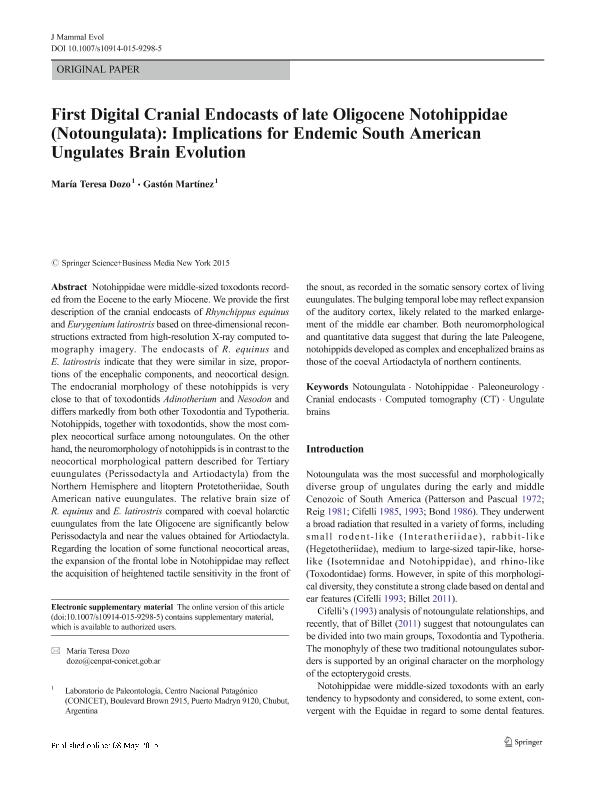Artículo
First digital cranial endocasts of late oligocene notohippidae (Notoungulata): implications for endemic south american ungulates brain evolution
Fecha de publicación:
08/05/2015
Editorial:
Springer
Revista:
Journal of Mammalian Evolution
ISSN:
1064-7554
e-ISSN:
1573-7055
Idioma:
Inglés
Tipo de recurso:
Artículo publicado
Clasificación temática:
Resumen
Notohippidae were middle-sized toxodonts recorded from the Eocene to the early Miocene. We provide the first description of the cranial endocasts of Rhynchippus equinus and Eurygenium latirostris based on three-dimensional reconstructions extracted from high-resolution X-ray computed tomography imagery. The endocasts of R. equinus and E. latirostris indicate that they were similar in size, proportions of the encephalic components, and neocortical design. The endocranial morphology of these notohippids is very close to that of toxodontids Adinotherium and Nesodon and differs markedly from both other Toxodontia and Typotheria. Notohippids, together with toxodontids, show the most complex neocortical surface among notoungulates. On the other hand, the neuromorphology of notohippids is in contrast to the neocortical morphological pattern described for Tertiary euungulates (Perissodactyla and Artiodactyla) from the Northern Hemisphere and litoptern Protetotheriidae, South American native euungulates. The relative brain size of R. equinus and E. latirostris compared with coeval holarctic euungulates from the late Oligocene are significantly below Perissodactyla and near the values obtained for Artiodactyla. Regarding the location of some functional neocortical areas, the expansion of the frontal lobe in Notohippidae may reflect the acquisition of heightened tactile sensitivity in the front of the snout, as recorded in the somatic sensory cortex of living euungulates. The bulging temporal lobe may reflect expansion of the auditory cortex, likely related to the marked enlargement of the middle ear chamber. Both neuromorphological and quantitative data suggest that during the late Paleogene, notohippids developed as complex and encephalized brains as those of the coeval Artiodactyla of northern continents.
Archivos asociados
Licencia
Identificadores
Colecciones
Articulos(CCT-CENPAT)
Articulos de CTRO.CIENTIFICO TECNOL.CONICET - CENPAT
Articulos de CTRO.CIENTIFICO TECNOL.CONICET - CENPAT
Citación
Dozo, Maria Teresa; Martínez, Gastón; First digital cranial endocasts of late oligocene notohippidae (Notoungulata): implications for endemic south american ungulates brain evolution; Springer; Journal of Mammalian Evolution; 23; 1; 8-5-2015; 1-16
Compartir
Altmétricas




